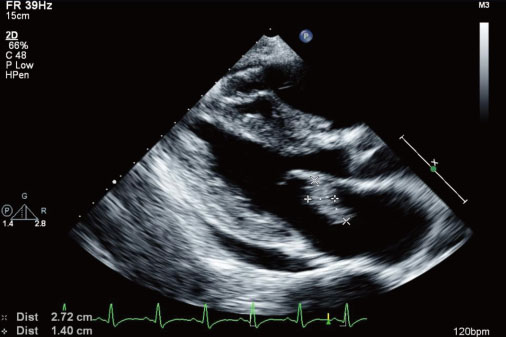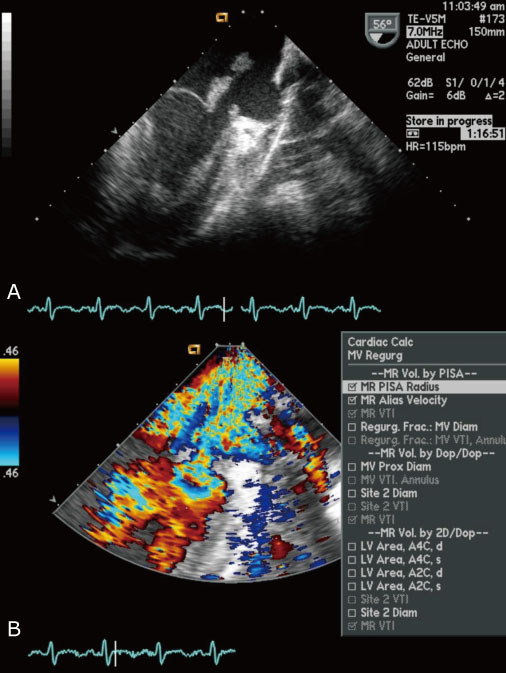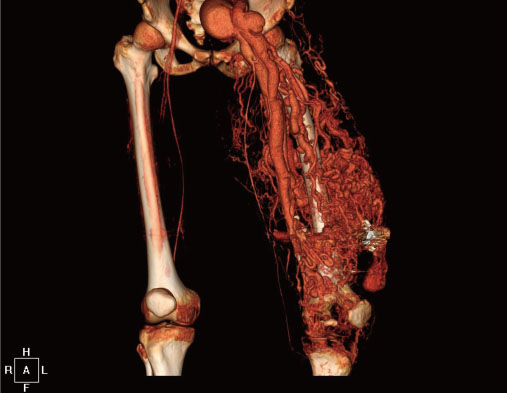Infect Chemother.
2010 Dec;42(6):415-419. 10.3947/ic.2010.42.6.415.
Successful Treatment of Recurrent Methicillin-resistant Staphylococcus aureus Bacteremia and Endocarditis by Linezolid, Valve Replacement, and Excisional Surgery of Limb in a Patient with Complicated Arteriovenous Malformation
- Affiliations
-
- 1Department of Internal Medicine, Hanyang University College of Medicine, Seoul, Korea. paihj@hanyang.ac.kr
- 2Department of Thoracic and Cardiovascular surgery, Hanyang University College of Medicine, Seoul, Korea.
- KMID: 2170323
- DOI: http://doi.org/10.3947/ic.2010.42.6.415
Abstract
- Vancomycin treatment failure in methicillin-resistant Staphylococcus aureus (MRSA) bacteremia patients has increased over the past decade. We experienced a case of repeated MRSA bacteremia resulting in left-side endocarditis in 38-year-old male with a huge complicated arteriovenous malformation in the left thigh. After vancomycin treatment failure, the patient was successfully treated with the administration of linezolid, leg amputation, and mitral valve replacement.
MeSH Terms
Figure
Reference
-
1. Avdic E, Cosgrove SE. Management and control strategies for community-associated methicillin-resistant Staphylococcus aureus. Expert Opin Pharmacother. 2008. 9:1463–1479.
Article2. Cosgrove SE, Fowler VG Jr. Management of methicillin-resistant Staphylococcus aureus bacteremia. Clin Infect Dis. 2008. 46:Suppl 5. S386–S393.3. Sakoulas G, Moellering RC Jr. Increasing antibiotic resistance among methicillin-resistant Staphylococcus aureus strains. Clin Infect Dis. 2008. 46:Suppl 5. S360–S367.4. Raad I, Narro J, Khan A, Tarrand J, Vartivarian S, Bodey GP. Serious complications of vascular catheter-related Staphylococcus aureus bacteremia in cancer patients. Eur J Clin Microbiol Infect Dis. 1992. 11:675–682.
Article5. Falagas ME, Manta KG, Ntziora F, Vardakas KZ. Linezolid for the treatment of patients with endocarditis: a systematic review of the published evidence. J Antimicrob Chemother. 2006. 58:273–280.
Article6. Jones RN. Microbiological features of vancomycin in the 21st century: minimum inhibitory concentration creep, bactericidal/static activity, and applied breakpoints to predict clinical outcomes or detect resistant strains. Clin Infect Dis. 2006. 42:Suppl 1. S13–S24.
Article7. Levine DP. Vancomycin: a history. Clin Infect Dis. 2006. 42:Suppl 1. S5–S12.
Article8. Sakoulas G, Moise-Broder PA, Schentag J, Forrest A, Moellering RC Jr, Eliopoulos GM. Relationship of MIC and bactericidal activity to efficacy of vancomycin for treatment of methicillin-resistant Staphylococcus aureus bacteremia. J Clin Microbiol. 2004. 42:2398–2402.
Article9. Hidayat LK, Hsu DI, Quist R, Shriner KA, Wong-Beringer A. High-dose vancomycin therapy for methicillin-resistant Staphylococcus aureus infections: efficacy and toxicity. Arch Intern Med. 2006. 166:2138–2144.
Article10. Micek ST. Alternatives to vancomycin for the treatment of methicillin-resistant Staphylococcus aureus infections. Clin Infect Dis. 2007. 45:Suppl 3. S184–S190.11. Grossi PA. Early appropriate therapy of Gram-positive bloodstream infections: the conservative use of new drugs. Int J Antimicrob Agents. 2009. 34:Suppl 4. S31–S34.
Article12. Falagas ME, Siempos II, Vardakas KZ. Linezolid versus glycopeptide or beta-lactam for treatment of Gram-positive bacterial infections: meta-analysis of randomised controlled trials. Lancet Infect Dis. 2008. 8:53–66.
Article13. Jang HC, Kim SH, Kim KH, Kim CJ, Lee S, Song KH, Jeon JH, Park WB, Kim HB, Park SW, Kim NJ, Kim EC, Oh MD, Choe KW. Salvage treatment for persistent methicillin-resistant Staphylococcus aureus bacteremia: efficacy of linezolid with or without carbapenem. Clin Infect Dis. 2009. 49:395–401.
Article14. Hill EE, Peetermans WE, Vanderschueren S, Claus P, Herregods MC, Herijgers P. Methicillin-resistant versus methicillin-sensitive Staphylococcus aureus infective endocarditis. Eur J Clin Microbiol Infect Dis. 2008. 27:445–450.
Article15. Han SS, Yim JJ, Yoo CG, Kim YW, Han SK, Shim YS, Lee SM. Clinical characteristics and risk factors for nosocomial candidemia in medical intensive care units: experience in a single hospital in Korea for 6.6 years. J Korean Med Sci. 2010. 25:671–676.
Article16. Mylonakis E, Calderwood SB. Infective endocarditis in adults. N Engl J Med. 2001. 345:1318–1330.
Article17. Garzon MC, Huang JT, Enjolras O, Frieden IJ. Vascular malformations: Part I. J Am Acad Dermatol. 2007. 56:353–370. quiz 71-4.
- Full Text Links
- Actions
-
Cited
- CITED
-
- Close
- Share
- Similar articles
-
- Community-acquired Methicillin-resistant Staphylococcus aureus Bacteremia Complicated by Acute Cholecystitis
- Methicillin-resistant Staphylococcus aureus Endocarditis after Sigmoidoscopy
- Fatal Peripheral Septic Thrombophlebitis Complicated with Infective Endocarditis due to Methicillin-resistant Staphylococcus aureus: A Case Report with Autopsy Findings
- A Case of Lactic Acidosis Caused by Linezolid Treatment of Persistent Methicillin-Resistant Staphylococcus Aureus Bacteremia
- A Case of Septic Arthritis Caused by Persistent MRSA Bacteremia with Successful Treatment Through Linezolid




